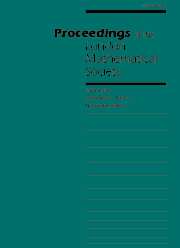Crossref Citations
This article has been cited by the following publications. This list is generated based on data provided by
Crossref.
Hausel, Tamás
and
Proudfoot, Nicholas
2005.
Abelianization for hyperkähler quotients.
Topology,
Vol. 44,
Issue. 1,
p.
231.
Hausel, Tamás
2005.
Geometric Methods in Algebra and Number Theory.
Vol. 235,
Issue. ,
p.
193.
Markman, Eyal
2007.
Integral generators for the cohomology ring of moduli spaces of sheaves over Poisson surfaces.
Advances in Mathematics,
Vol. 208,
Issue. 2,
p.
622.
Biswas, Indranil
and
Muñoz, Vicente
2007.
The Torelli theorem for the moduli spaces of connections on a Riemann surface.
Topology,
Vol. 46,
Issue. 3,
p.
295.
Hausel, Tamás
and
Rodriguez-Villegas, Fernando
2008.
Mixed Hodge polynomials of character varieties.
Inventiones mathematicae,
Vol. 174,
Issue. 3,
p.
555.
de Cataldo, Mark
Hausel, Tamás
and
Migliorini, Luca
2012.
Topology of Hitchin systems and Hodge theory of character varieties: the case A_1.
Annals of Mathematics,
Vol. 175,
Issue. 3,
p.
1329.
Zhang, Wei
2014.
Convergence of Yang-Mills-Higgs flow for twist Higgs pairs on Riemann surfaces.
Science China Mathematics,
Vol. 57,
Issue. 8,
p.
1657.
Letellier, Emmanuel
2015.
Character varieties with Zariski closures of $$\mathrm{GL}_n$$ GL n -conjugacy classes at punctures.
Selecta Mathematica,
Vol. 21,
Issue. 1,
p.
293.
García-Raboso, Alberto
and
Rayan, Steven
2015.
Calabi-Yau Varieties: Arithmetic, Geometry and Physics.
Vol. 34,
Issue. ,
p.
131.
Simpson, Carlos
2016.
The dual boundary complex of theSL2character variety of a punctured sphere.
Annales de la Faculté des sciences de Toulouse : Mathématiques,
Vol. 25,
Issue. 2-3,
p.
317.
Li, Jiayu
and
Zhang, Xi
2017.
The Limit of the Yang–Mills–Higgs Flow on Higgs Bundles.
International Mathematics Research Notices,
Vol. 2017,
Issue. 1,
p.
232.
Zúñiga-Rojas, Ronald A.
2018.
Stabilization of the Homotopy Groups of the Moduli Spaces of k-Higgs Bundles.
Revista Colombiana de Matemáticas,
Vol. 52,
Issue. 1,
p.
9.
Aparicio-Arroyo, Marta
Bradlow, Steven
Collier, Brian
García-Prada, Oscar
Gothen, Peter B.
and
Oliveira, André
2019.
$$\mathrm {SO}(p,q)$$-Higgs bundles and Higher Teichmüller components.
Inventiones mathematicae,
Vol. 218,
Issue. 1,
p.
197.
Zúñiga-Rojas, Ronald A.
2021.
Variations of hodge structures of rank three k-Higgs bundles and moduli spaces of holomorphic triples.
Geometriae Dedicata,
Vol. 213,
Issue. 1,
p.
137.
Yoo, Sang-Bum
2021.
A Desingularization of the Moduli Space of Rank 2 Higgs Bundles over a Curve.
Taiwanese Journal of Mathematics,
Vol. 25,
Issue. 2,
Swoboda, Jan
2021.
Moduli Spaces of Higgs Bundles – Old and New.
Jahresbericht der Deutschen Mathematiker-Vereinigung,
Vol. 123,
Issue. 2,
p.
65.
Jeffrey, Lisa
Lindberg, Aidan
and
Rayan, Steven
2021.
Explicit Poincaré duality in the cohomology ring of the SU(2) character variety of a surface.
Expositiones Mathematicae,
Vol. 39,
Issue. 3,
p.
411.
Zamora Saiz, Alfonso
and
Zúñiga-Rojas, Ronald A.
2021.
Geometric Invariant Theory, Holomorphic Vector Bundles and the Harder-Narasimhan Filtration.
p.
101.
de Cataldo, Mark
Maulik, Davesh
and
Shen, Junliang
2021.
Hitchin fibrations, abelian surfaces, and the P=W conjecture.
Journal of the American Mathematical Society,
Vol. 35,
Issue. 3,
p.
911.
Gothen, Peter B.
and
Zúñiga-Rojas, Ronald A.
2022.
Stratifications on the nilpotent cone of the moduli space of Hitchin pairs.
Revista Matemática Complutense,
Vol. 35,
Issue. 2,
p.
311.


